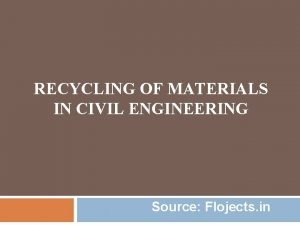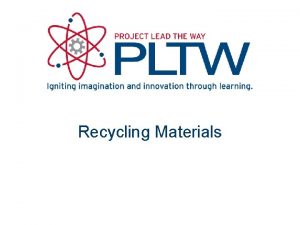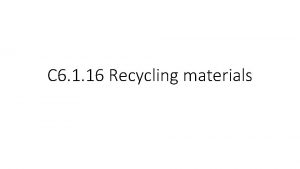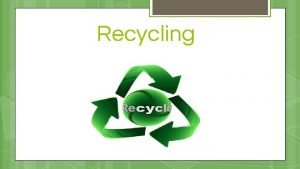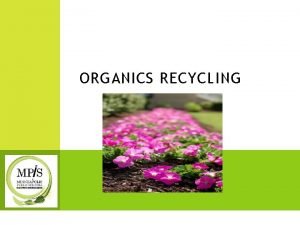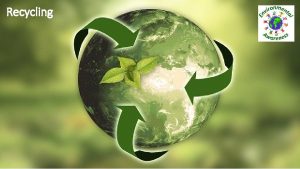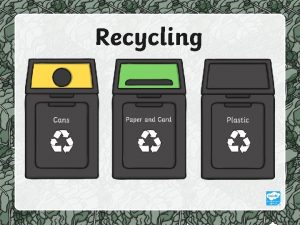RECYCLING OF MATERIALS IN CIVIL ENGINEERING Source Flojects











- Slides: 11

RECYCLING OF MATERIALS IN CIVIL ENGINEERING Source: Flojects. in

INTRODUCTION RECYCLING is the process of converting waste materials into new materials and objects. It is an alternative to "conventional" waste disposal that can save material.

IMPORTANCE OF RECYCLING When we recycle, used materials are converted into new products, reducing the need to consume natural resources. If used materials are not recycled, new products are made by extracting fresh, raw material from the Earth.

IMPORTANCE OF RECYCLING MATERIALS IN CIVIL ENGINEERING v v Various types of recyclable materials are currently used in civil engineering applications. These include tire shreds, ground tire rubber, fly and bottom ash, blast-furnace slag, steel slag, cement kiln dust, silica fume, etc. Reutilization of these recyclable materials is especially beneficial in civil engineering applications that require large volumes of materials.

MATERIALS THAT CAN BE RECYCLED FROM CONSTRUCTION SITES INCLUDE; AGGREGATES BRICKS WOOD GLASS STEEL FROM REINFORCING WIRE.

RECYCLED AGGREGATES Recycled aggregates is a term used to describe crushed concrete or asphalt from construction debris that is reused in other building projects. This collection of construction refuse is mainly used for road base, cement concrete or other infrastructure projects.

BRICKS The most common sources of brick and block waste include items that are damaged during unloading, storage and cutting, and excess due to over ordering. Bricks are easy to recycle when arrangements are made beforehand. Bricks are recycled in several ways. They can be chipped and used in landscapes. Bricks, when crushed into very fine material, can also be used in place of sand or even go into new bricks.

WOOD Wood which has been pressure treated, painted, varnished or otherwise finished is not a good candidate for recycling. Take wood to civic amenity sites for recycling. Wood can often be reused to make other items, such as a bird table for your garden. Wood can often be added to your compost heap, such as sawdust and wood shavings. Buy recycled wood whenever possible.

GLASS Glass recycling is the processing of waste glass into usable products. Glass that is crushed and ready to be remelted is called cullet. The consumer throws glass into a recycle bin. Glass is taken from the bin and taken to a glass treatment plant. The glass is sorted by colour and washed to remove any impurities. The glass is then crushed and melted, then moulded into new products such as bottles and jars. Then this glass can be used for fixing windows etc.

CONCLUSION Instead of extracting natural resources we can use waste materials by recycling it in a proper way which is more economical.

THANK YOU Visit Flojects. in for Question Papers, Activities & Presentations
